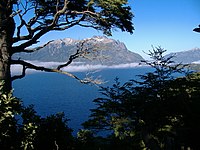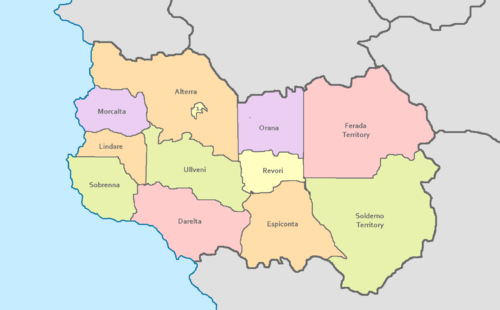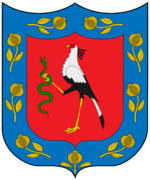Darona: Difference between revisions
mNo edit summary |
mNo edit summary |
||
| Line 106: | Line 106: | ||
|footnote7 = | |footnote7 = | ||
}} | }} | ||
'''Darona''' ([[Daronian language|Daronian]]: ''Daroná''), officially the '''Federal Republic of Darona''' ([[Daronian language|Daronian]]: ''Respublica Foederaló Daroná''), is a {{wp|sovereign state}} in [[Elia Austral]] and shared a border with [[X]] to the south, [[X]] to the east, [[X]] and [[ | '''Darona''' ([[Daronian language|Daronian]]: ''Daroná''), officially the '''Federal Republic of Darona''' ([[Daronian language|Daronian]]: ''Respublica Foederaló Daroná''), is a {{wp|sovereign state}} in [[Elia Austral]] and shared a border with [[X]] to the south, [[X]] to the east, [[X]] and [[Nadauro]] to the north. Darona has an extensive coastline to the west along the [[Medan Ocean]]. The capital and largest city in Darona is [[Arganti]] which is located in the northern part of the country inland on the Ovenna river on the plain of Ovenna. Other major settlements in Darona include [[Porto Ferusa]], [[Terlanta]] and [[Sabrenno]] on the south west coast in what is known as the western urban belt and further inland the northern cities of [[Mareva]] and [[Colpera]]. | ||
{{wp| Indigenous peoples of South America|Indigenous peoples}} began to settle what today is known as Darona 12,000 years ago. The first settlers from [[!Europe]] explored the region in the early 1600s and the land around the Western coast and what is today known as the Ovenna valley was claimed by [[X]]. The colonial stronghold over the territory increasingly became seen as overbearing by the populace of what was then Darona and certain intellectuals in the colony established an ideology centred around a free republican Darona with democratic and liberal ideals. This sparked a series of revolts and revolutions which initially granted further autonomy for the colony however in the early 19th century the revolutionary ideas of the previous century re-emerged in a new generation and this led to what is known to most Daronians as [[The Great Revolution]] after which in 1819 full autonomy was achieved. Following independence the already strong economy in the region boomed with cross ocean trade and in 1832 Darona purchased as well as annexed vast swathes of land east of its original colonial territory to its east. This happened over the course of five years and is referred to as the great expansion. Darona began as a democratic state up until 1943 when a severe economic crisis and the subsequent depression occurring in its aftermath leading to violent unrest and the overthrow of the elected government by military leaders. This military dictatorship would last up until 1983 with the peaceful revolution restoring democracy. | {{wp| Indigenous peoples of South America|Indigenous peoples}} began to settle what today is known as Darona 12,000 years ago. The first settlers from [[!Europe]] explored the region in the early 1600s and the land around the Western coast and what is today known as the Ovenna valley was claimed by [[X]]. The colonial stronghold over the territory increasingly became seen as overbearing by the populace of what was then Darona and certain intellectuals in the colony established an ideology centred around a free republican Darona with democratic and liberal ideals. This sparked a series of revolts and revolutions which initially granted further autonomy for the colony however in the early 19th century the revolutionary ideas of the previous century re-emerged in a new generation and this led to what is known to most Daronians as [[The Great Revolution]] after which in 1819 full autonomy was achieved. Following independence the already strong economy in the region boomed with cross ocean trade and in 1832 Darona purchased as well as annexed vast swathes of land east of its original colonial territory to its east. This happened over the course of five years and is referred to as the great expansion. Darona began as a democratic state up until 1943 when a severe economic crisis and the subsequent depression occurring in its aftermath leading to violent unrest and the overthrow of the elected government by military leaders. This military dictatorship would last up until 1983 with the peaceful revolution restoring democracy. | ||
Revision as of 19:41, 13 June 2023
Federal Republic of Darona Respublica Foederaló Daroná (Daronian) | |
|---|---|
Motto: "Fortitudo in Adminicula" "Strength in Community" | |
Anthem: "A Patrio, A Omnio" | |
| Capital | Arganti |
| Largest city | Sobrenna |
| Official languages | Daronian |
| Demonym(s) | Daronian |
| Government | Federal Parliamentary republic |
| Francisco Arella | |
| Elisabeth Morena | |
| Legislature | National Congress |
| Senate | |
| Chamber of Deputies | |
| Independence from X | |
• Declared | 7 May 1819 |
• 9 August 1832 Expansion | 26 January 1943 Dictatorship |
| 29 May 1972 | |
| Area | |
• Total | 2,696,751 km2 (1,041,221 sq mi) |
| Population | |
• 2022 census | 47,789,890 |
• Density | 17.72/km2 (45.9/sq mi) |
| GDP (PPP) | 2022 estimate |
• Total | $1.294 trillion |
• Per capita | $28,990 |
| GDP (nominal) | 2022 estimate |
• Total | $781.1 billion |
• Per capita | $16,970 |
| Gini (2022) | medium |
| HDI (2022) | very high |
| Currency | Daronian Quaesta (DQS) |
| Time zone | UTC-1 |
| Date format | dd/mm/yyyy |
| Driving side | right |
Darona (Daronian: Daroná), officially the Federal Republic of Darona (Daronian: Respublica Foederaló Daroná), is a sovereign state in Elia Austral and shared a border with X to the south, X to the east, X and Nadauro to the north. Darona has an extensive coastline to the west along the Medan Ocean. The capital and largest city in Darona is Arganti which is located in the northern part of the country inland on the Ovenna river on the plain of Ovenna. Other major settlements in Darona include Porto Ferusa, Terlanta and Sabrenno on the south west coast in what is known as the western urban belt and further inland the northern cities of Mareva and Colpera.
Indigenous peoples began to settle what today is known as Darona 12,000 years ago. The first settlers from !Europe explored the region in the early 1600s and the land around the Western coast and what is today known as the Ovenna valley was claimed by X. The colonial stronghold over the territory increasingly became seen as overbearing by the populace of what was then Darona and certain intellectuals in the colony established an ideology centred around a free republican Darona with democratic and liberal ideals. This sparked a series of revolts and revolutions which initially granted further autonomy for the colony however in the early 19th century the revolutionary ideas of the previous century re-emerged in a new generation and this led to what is known to most Daronians as The Great Revolution after which in 1819 full autonomy was achieved. Following independence the already strong economy in the region boomed with cross ocean trade and in 1832 Darona purchased as well as annexed vast swathes of land east of its original colonial territory to its east. This happened over the course of five years and is referred to as the great expansion. Darona began as a democratic state up until 1943 when a severe economic crisis and the subsequent depression occurring in its aftermath leading to violent unrest and the overthrow of the elected government by military leaders. This military dictatorship would last up until 1983 with the peaceful revolution restoring democracy.
Darona is a developed country and ranks highly in measures of human development and has a high standard of living. Following the end of dictatorship in 1983 and emergence from geopolitical isolation Darona has become an increasingly important player on the international stage and a key regional power and influence.
Etymology
History
Pre-colonial history
Colonial period
Independence and early nationhood
19th Century and Expansion
Early 20th century
Crisis of 1943 and the Ruis Dictatorship
Restoration of Democracy
Modern History
Geography
With an area of 2,696,751 sq km Darona is one of Teleon's largest countries and as such it's landscape varies wildly throughout its's vast interior going from high mountains in the South and northeast to fertile central valleys, from lake dotted land to dry arid steppe. This along with an extensive coastline along the Southern Medan ocean and river system makes Darona extremely variable from one end of the country to the next. To protect this landscape there are a network of 38 Daronian national parks all across the nation.
Mountainous regions in Darona lie primarily in the far northeast stretcging through the Ferada Territory into the Solderno Territory. These are the Palta Mountains and are the highest range in Darona. Darona's highest peak Palta Major is loacted in the Ferada Territory at 6,789 m although the average height of the entire range is about 4,000 m. Other large mountain ranges in Darona include the northern much smaller Altero mountain range and the Ruas mountains which stretch from the south across into the country's interior like a snake.
Major rivers of Darona include the Ovenna which is the country's most important and longest river which transverses almost the length of the country from the Palta ranges in the northeast and is discharged into the Medan. The four valleys that run along the Ovenna are the most populated part of the country apart from its coast and include cities like Colpera and Darona's capital Arganti.
Climate
Due to its vast size the climate of Darona is highly varied. Most of Darona has a warm Temperate climate although this varies in it's far eastern interior where the climate is colder and more arid rising into the Palta range. Most of the Daronian population resides in the temperate parts of the country. The coastal parts of Darona are characterised by no dry season and plenty of rainfall with high temperatures.The central inland part of Darona also gets hot humid summers with mild and dry winters. The south east is like this as well except for it having slightly cooler winters. Due to the obstruction of clouds by the Palta mountain range parts of the east of the country such as the territories of Ferada and Solderno are drier and semi-arid with dense forest coverage although temperatures here vary in extremes. The central provinces of Alterra, Ulvenni and Darelta are all the most suited to agriculture with cloufy hot and humid weather.
Environment and Biodiversity
Darona is extremely Biodiverse with many different ecosystems within its territory. Darona is home to thousands of species of birds, mammals, reptiles and amphibians and Darona's central landscape contains primarily Mollisol surface soils making the region extremely good for agriculture. The national park network of Darona which includes 38 national parks across the federal republic is responsible for the protection of Darona's biodiverse landscape and ecosystems.
Politics
The politics of Darona function within the system of a Parliamentary Federal Republic built on the ideals of democracy and equality. There are three main branches of the Daronian government. The head of state of Darona acts as a figure head representing the country internationally but in practice is a symbol of the state with real power being vested in the Prime Minister of Darona, their cabinet and the Bicameral legislature the National Congress of Darona.

Darona can be described as a full democracy built on a foundation of Liberalism, Egalitariansm and Republicanism. Civil rights and liberties as well as moderate politics and freedom of speech and expression have been long held and important institutions in Daronian politics since the re establishment of democracy in 1983 and the return of the 1819 constitution.
Darona has a Multi-party system which has been dominated by four main parties since the re establishment of democracy in 1983. These are the centre left People's Party, The centrist party Unity!, the conservative centre right party Republic and the Voice of the People Party. There are also provincial parties spread across Darona's 9 Provinces and territorial parties in the two Territories of Darona.
Government

Darona has a parliamentary system within the framework of a Federal Republic and three branches of government. Executive, Legislative and Judicial. The head of state of Darona is an elected ceremonial role that has no real executive power but instead serves as a national symbol and figure head representing the country diplomatically overseas. Real executive power is vested in the hands of the prime minister of Darona who is the leader of the largest party elected to the lower house of the National Congress of Darona the House of Deputies. This ususally ranges between the four main parties although out of the four the two main parties are seen to be the centre right and centre left parties with the other two either unable to win enough seats to from a government on their own or helping the other two take a majority by forming a coaltion government. This is the situation currently between the centrist Unity! party and centre left People's Party with Unity! being the first party outside of the traditional two to lead a government since the end of dictatorship in 1983.
The legislative branch takes form in the bicameral legislature the National Congress. The lower house, the House of Deputies is elected by plurality from each of Darona's 298 electoral districts with elections to the House of Deputies occuring every 4 years. Legislative power is also divided between the federal legislators and the 9 autonomous provincial legislatures which are all unicameral as well as the 3 territorial legislatures which have less responsibility than their provincial counterparts. Powers provded to provnicial legslatures include education and municipal government but cannot make decsions on matters that the federal legislature can such as foreign policy, military, currency and banking. Other powers include the punishment of crime, taxes and agriculture. The upper house of the National Congress the Senate of Darona is a group appointed by the president on the advice of the prime minister and its members are there to represent equally the provinces and territories of Darona with the number of senators from each province being based on their population and there being 2 senators for each territory.
The judiciary of Darona plays an important role in the government. The highest court in Darona is the supreme court whose members are appointed by the president on the advice of the prime minister and the federal cabinet following review from three non governmental bodies. Throughout Darona Civil law predominates. Criminal courts are a devolved provincial matter rather than a federal one with law enforcement in the hands of municipal police forces.
Political parties and elections
Daronian elections happen across several spheres at a federal, provincial and territorial level. During National Federal elections Daronian voters vote for their local member of Congress through Plurality voting who represent that electoral district in the House of Deputies. Almost all members of congress are linked to one of the four main poltical parties and it is the leader of the largest party or the leader with the most confidence from the congress that forms the next federal cabinet. If Congress looses confidence in a government snap elections can be called. Elections in Darona are set to happen every four years.
In provincial and territorial elections follow a similar pattern to their federal counterpart however in certain provinces there are regional parties some with links to a larger federal party and some independent of them completely. All four of the federal parties now have provincial and territorial wings although two provinces and one territory are now ruled by non-federally affialiated parties.
Administrative divisions
Darona is split into 9 provinces and 3 territories one of which is the Arganti capital territory. The difference between a province and a territory lies in the fact that territories have no inherent sovereignty and have their powers delegated to them by the National Congress of Darona. The two Daronian territories lie in the far east of the Daronian land mass. The 9 provinces all have a high degree of autonomy and all 12 divisions have their own unicameral legislatures. The vast amjority of the population lives in the coatal provinces of Sobrenna, Lindare and Morcalta and the province of Alterra. The most populated territory is the Arganti Capital Territory which is surrounded by the province of Alterra.
Foreign relations
Military

The Armed Forces of Darona is comprised of three branches. The army, navy and air force and is overseen by the federal government and ministry of the interior. It's ceremonial commander in cheif is the President of Darona. The goal of the armed forces of Darona are to defend the Daronian nation and it's territory, it's people and it's sovereignty. Universal Conscription is in place in Darona in which all Daronian nationals above the age of 18 are expected to serve in the armed forces for 6-12 months. Daronian military spending is one of the highest in the world and Darona has fostered a culture of homeland defence as well as maintained a strong and capable military. The Daronian armed forces have also taken part in several peace keeping exercises along with key allies such as Helmenland before and regularly cooperate with other allied militaries.











